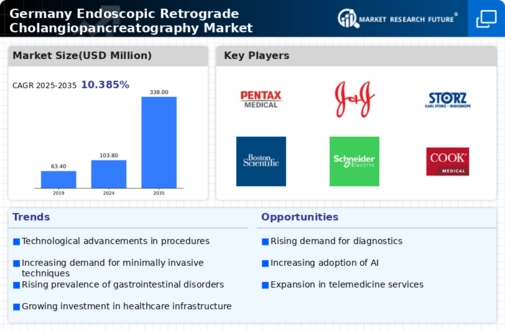Rising Incidence of Biliary Disorders
The increasing prevalence of biliary disorders in Germany is a significant driver for the endoscopic retrograde-cholangiopancreatography market. Conditions such as gallstones, cholangitis, and pancreatitis are becoming more common, leading to a higher demand for diagnostic and therapeutic procedures. According to recent health statistics, biliary disorders affect approximately 10-15% of the population, which translates to millions of potential patients requiring endoscopic interventions. This growing patient base is likely to stimulate the market, as healthcare providers seek effective solutions to manage these conditions. Furthermore, advancements in endoscopic techniques and equipment are enhancing the efficacy of these procedures, making them more appealing to both patients and healthcare professionals. As a result, the endoscopic retrograde-cholangiopancreatography market is poised for growth in response to this rising incidence.
Technological Innovations in Endoscopy
Technological advancements in endoscopic equipment and techniques are driving the endoscopic retrograde-cholangiopancreatography market in Germany. Innovations such as high-definition imaging, narrow-band imaging, and improved endoscope designs are enhancing the precision and safety of procedures. These advancements not only improve diagnostic accuracy but also reduce the risk of complications, thereby increasing the adoption of endoscopic retrograde-cholangiopancreatography among healthcare providers. The market is witnessing a shift towards minimally invasive techniques, which are preferred by both patients and clinicians. As hospitals and clinics invest in state-of-the-art technology, the demand for endoscopic procedures is expected to rise. This trend indicates a robust growth trajectory for the endoscopic retrograde-cholangiopancreatography market, as healthcare facilities strive to offer the best possible care to their patients.
Increased Focus on Patient Safety and Outcomes
The emphasis on patient safety and improved clinical outcomes is significantly influencing the endoscopic retrograde-cholangiopancreatography market. Healthcare providers in Germany are increasingly prioritizing procedures that minimize risks and enhance recovery times. This focus is driving the adoption of endoscopic retrograde-cholangiopancreatography, as it is associated with lower complication rates compared to traditional surgical methods. Moreover, the integration of safety protocols and quality assurance measures in healthcare settings is likely to boost confidence among patients and providers alike. As hospitals strive to meet regulatory standards and improve patient satisfaction, the demand for safe and effective endoscopic procedures is expected to rise. This trend suggests a positive outlook for the endoscopic retrograde-cholangiopancreatography market, as it aligns with the broader goals of enhancing patient care.
Growing Investment in Healthcare Infrastructure
The expansion of healthcare infrastructure in Germany is a crucial driver for the endoscopic retrograde-cholangiopancreatography market. With increased funding for hospitals and clinics, there is a greater capacity to offer advanced medical procedures, including endoscopic interventions. The German government has been actively investing in healthcare facilities, aiming to enhance patient care and access to specialized treatments. This investment is likely to lead to the establishment of more endoscopy units equipped with the latest technology, thereby facilitating a higher volume of endoscopic retrograde-cholangiopancreatography procedures. Additionally, the focus on improving healthcare accessibility in rural areas may further boost the market, as more patients gain access to necessary diagnostic and therapeutic services. Consequently, the endoscopic retrograde-cholangiopancreatography market is expected to benefit from this growing investment in healthcare infrastructure.
Rising Demand for Minimally Invasive Procedures
The growing preference for minimally invasive procedures among patients is a notable driver for the endoscopic retrograde-cholangiopancreatography market. Patients are increasingly seeking alternatives to traditional surgical interventions due to the associated benefits, such as reduced pain, shorter recovery times, and minimal scarring. Endoscopic retrograde-cholangiopancreatography offers a less invasive option for diagnosing and treating biliary and pancreatic disorders, making it an attractive choice for both patients and healthcare providers. As awareness of these benefits spreads, the demand for such procedures is likely to increase. Additionally, the aging population in Germany, which is more prone to biliary disorders, further fuels this demand. Consequently, the endoscopic retrograde-cholangiopancreatography market is expected to experience growth as it aligns with the evolving preferences of patients seeking effective and less invasive treatment options.



















Leave a Comment